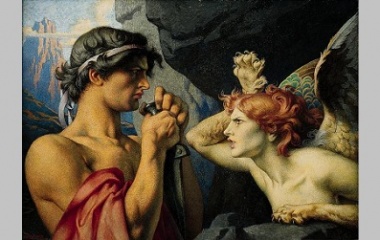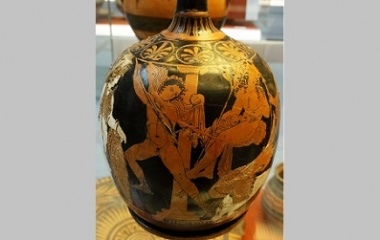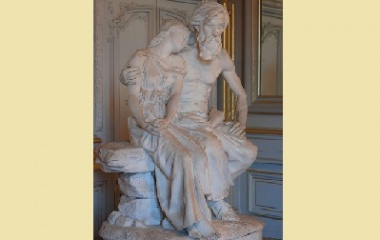- Pronunciation: ED-e-puss
- Origin: Greek
- Role: King
- Symbol: Eyes
- Parents: King Lauis and Queen Jacosta
- Children: Polynices, Eteocles, Antigone, and Ismene
- Other Names: Oidipus, Oidipous
Who Is Oedipus?
In Greek mythology, Oedipus was the king of Thebes, a city that played a central role in many myths.
Purpose
As king of Thebes, Oedipus was responsible for ruling over the land and residents with a fair hand. However, his myth ends with tragedy.
Origins
The myth of Oedipus is sourced from Sophocles’ Oedipus Rex and Oedipus at Colonus.
Legends and Stories
There is one main myth that tells the story of Oedipus, starting from his childhood and ending with him administering his own punishment for a mistake he never knew he made.
The Myth of Oedipus
King Lauis and Queen Jocasta ruled over Thebes. They were desperate to have a child but the months kept coming without the news of a pregnancy. King Lauis consulted with the Oracle at Delphi to see what the future held for him and his wife. He learned that they would have a son, but eventually this child would kill them both.
King Lauis had difficulty believing the prophecy but when Queen Jocasta finally did get pregnant, he decided to take fate into his own hands. He commanded his servants pierce holes into his baby’s ankles, preventing him from crawling. This is how his name was chosen, as Oedipus means “swollen foot”. Queen Jocasta then commanded that the baby be brought to the mountains to die. Oedipus was handed to a shepherd, but the man was unable to bring himself to kill the child. Instead, he gave Oedipus to another shepherd, who brought him to King Polybus and Queen Merope of Corinth.
King Polybus and Queen Merope did not have children so they adopted the baby and raised him as their own. Oedipus grew and flourished but when he was old enough to understand, someone told him that his parents were not his biological parents. Oedipus started to investigate and found himself asking the Oracle of Delphi. It was there that he received a prophecy. He would kill his father and marry his mother. Oedipus assumed that the prophecy was about King Polybus and Queen Merope, so he didn’t return home. Instead, he headed to Thebes.
As he was nearing the town, he came across a charioteer. The two ended up quarreling, which quickly escalated to fighting. Oedipus killed the charioteer, which ended up being King Laius. Without realizing it, Oedipus had fulfilled the first half of the prophecy.
He continued on his journey and came across a monster named Sphinx, who had plagued Thebes for years. He would kill travelers who were unable to answer his riddles. He asked Oedipus his favorite riddle; what walks on four feet in the morning, two in the afternoon, and three at night? No other traveler had ever answered the question right before but Oedipus took his time, thinking carefully, until he finally answered—man. The Sphinx was in shock. Man was the right answer, as he crawls on all fours as a baby, walks on two legs as an adult, and uses a walking stick as he ages. The monster couldn’t accept that someone had answered his riddle, so he jumped off the rock he was sitting on and killed himself.
Oedipus finally reached Thebes, where he was welcomed as a hero by Creon, Queen Jocasta’s brother, who was serving as a temporary king. Creon said that because Oedipus had killed the dreaded Sphinx, he would become king and marry Queen Jocasta. Without realizing it, Oedipus had fulfilled the second half of his prophecy.
Together, Oedipus and Queen Jocasta had four children, Eteocles, Polynices, Antigone, and Ismene. Years later, Thebes was going through a difficult time as a city. Oedipus asked Creon to go to the Oracle at Delphi to learn why the city was suffering. Creon was told it was because King Laius’ killer had not been brought to justice. Oedipus demanded that the Oracle tell them who the killer was. Eventually, it came out that Oedipus was the killer. Oedipus and Creon fought and Queen Jocasta told them the story of her first baby, whom she believed had been killed.
A messenger from Corinth arrived right after this and told Oedipus that King Polybus had died. At first, Oedipus was relieved because he believed his prophecy wouldn’t come true. Oedipus refused to attend the funeral, in case he saw his mother and the second part of the prophecy somehow materialized. But the messenger told Oedipus that he was adopted and that King Polybus and Queen Merope were not his biological parents.
Suddenly, it became clear to Oedipus that he had killed his true father and that he had married his biological mother. Oedipus set out to find Queen Jocasta, who had ran away when the truth became clear to everyone. When he found her, he was too late. She had hung herself. Oedipus took a brooch from his wife’s gown and used it to prick out his own eyes and blind himself. He then fled Thebes, being guided by his daughter Antogone. He headed to Athens, where he was welcomed. He would eventually die in the city, troubled by his past.
Family
Oedipus’ parents were King Lauis and Queen Jocasta. He didn’t know it until much later, but he married his mother. Together, they had four children, named Polynices, Eteocles, Antigone, and Ismene.
Appearance
In artistic representations, Oedipus is usually shown with dark hair and a beard. He wears a short white tunic. In some representations, he is able to see. In others, he is shown blind, the aftermath of gouging out his own eyes.
Symbology
The main symbols of Oedipus and his myth are eyes, both open and closed. A set of open and capable eyes represent ignorant pride. Blinded eyes, even though they can no longer see, represent knowledge, symbolizing that there is more to being wise than seeing your surroundings.










